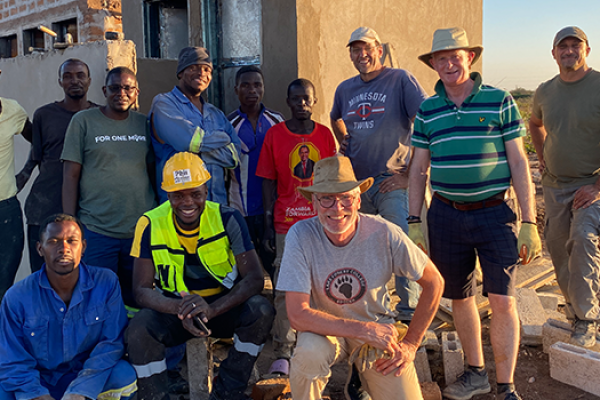How To Value, Respect and Safeguard Children When Posting Online

Can you keep up?! Today’s digital world is very different from the digital world of ten years ago, five years ago... in fact probably even last month! So, is what worked last year or last decade adequate today in regard to safeguarding children when posting online?
Let’s be honest, we all absolutely love to see a cute video of a baby giggling or see celebratory photos of a school’s graduation or sports tournament. Images such as these can bring everyone involved great joy and are a delight to see pop up on our phone. Part of community living is celebrating each other’s delights and witnessing happy moments which of course often involve children. That is wonderful! This article is not to negate that at all but rather help each of us individually ponder and assess how we can continue to respect and safeguard children when posting online in today’s digital world.
Let’s start with two questions:
- Where do we post about children? We might post about our own children or our students on social media sites, blogs, websites, promotional adverts, magazines or in newsletters.
- Why do we post about children online? Answers may include because we want to share a positive, happy story, raise awareness of the plight of certain children or share about our ministry which involves children. All genuinely good reasons.
However, if we are honest, there may be times where we are highlighting a child because we desire to unhealthily leverage this relationship to brag about our ministry or to raise money. Recently when the TeachBeyond Safeguarding Team conducted research as to why fundraisers often use children's images in their promotional materials one repeated answer was because, “children’s images sell”. Think about that; “children’s images sell”. How can this be done in a way that protects and respects children?
Sarah was privately worshipping during her school’s chapel time when she sensed someone was taking a photo without permission. Sure enough, a week later, a photo of her with her arms outstretched praising the Lord was posted on all the school’s promotional materials. Many people commented and soon she was seen as the “poster Christian student” of the school. Initially she enjoyed the attention but gradually she felt the pressure to continue to “perform” during chapel. Her worship started to feel hollow, and she felt ashamed.
You may not think the above example is anything to do with safeguarding—it seems innocent enough, However, there is something deeper going on. Firstly, it is about Sarah’s privacy that was taken without permission. It is also about integrity and how we may be tempted to use an image to make an impression or enhance our organisation or ministry’s reputation without thinking of the impact on the child.
We all know that if we post about a child into the digital sphere, it will be there forever as part of their digital footprint, even if we delete it. The digital sphere is not just the Open Web that we all can see but also the Deep and Dark web where dangerous and illicit content is stored.
 Children’s information sadly can also be stolen and exploited, and children’s images can be manipulated. We are hearing more and more reports of children's images being edited with AI into an abusive sexual image and then the children being bribed for money or extorted with other threats.
Children’s information sadly can also be stolen and exploited, and children’s images can be manipulated. We are hearing more and more reports of children's images being edited with AI into an abusive sexual image and then the children being bribed for money or extorted with other threats.
John was shocked when he received a private message on his Instagram. Someone had manipulated a photo of him playing football into a photo of him abusing a girl. You could not tell it was fake at all! He was horrified and immediately was sick in the bathroom. A second message appeared asking him for 100 dollars otherwise the photo would be posted on his hacked account.
Interestingly, our children today often have more awareness of the digital world than we do. Famously Gwyneth Paltrow, the actress, once posted a happy image of her teenage daughter and herself on her Instagram with millions of followers. Her daughter replied in the comments, “Mom we have discussed this. You may not post anything without my consent.” Joanne Orlando, Children and Tech Researcher, stated “Children have the right to privacy. This is actually one of the Conventions of the Rights of Childhood... Parents are in a holding position of creating their child’s digital identity, and because of this temporary role, it’s important to err on the side of caution. That means caution in terms of how much of their life you are sharing, and the spin you add to the video, images and comments you post.”1
We must ensure children have a voice and that their rights are adhered to and acknowledge the considerable power imbalances that can be at play in both the production and consumption of images of children. The legal global agreement, United Nations Conventions of the Child (UNRCR), states in Article 3 (paraphrased) “The best interests of the child must be a top priority in all decisions and actions that affect children” and in Article 16, (paraphrased) “Every child has the right to privacy.”2 However, our calling as transformed followers of Jesus goes beyond what is just considered “legal”. Children are a blessing and heritage from God. Our biblical mandate and responsibility are to value and care for children, aiming to reduce the risk of harm and ensure that children can come to Him without hinderance as part of God’s ongoing mission to transform individuals and communities into all He intends.

So, how can we continue to safeguard children well and respect their privacy when posting online? How can we follow ethical considerations, especially for more vulnerable children? How can we grow in safeguarding awareness for today’s digital world? Here are some top tips to ponder:
- Let’s prioritise the rights and needs of the child. Even if we have consent to post, is this in the best interests of the child? Why am I doing this? Who benefits? Does this betray the child’s privacy and trust?
- Let's ensure online communications do no harm. Might sharing this image or information of this child harm them in any way, presently or in the future? How will the post make the child feel if he or she ever reads it? If the child’s peers found the post, how would/could they use it? Will the post add pressure to the child to be perfect or brag worthy?
- Let’s ensure we obtain informed consent. Informed consent is permission that a person grants to be photographed, or information gathered, with full knowledge of where, when, how, and for what purpose the image and information will be used, and with the understanding that they can say “no” without consequence. Informed consent is the cornerstone of ethical content gathering and use. It is much more than asking parents or children to fill in the “Media Permission slip” alone. It requires meaningful dialogue and is about listening and allowing questions. One question for us all to ponder is when should we start asking for informed consent from children, rather than just their parents? Something we all need to think about in our contexts.
- Let’s ensure a responsible portrayal. “The single story creates stereotypes, and the problem with stereotypes is not that they are untrue, but that they are incomplete. They make one story become the only story.”3 (Chimamanda Ngozi Adichie) Photos of sad looking, poverty-stricken children have been frequently used to help raise funds for international charities. Many now ask if images such as these have promoted emotion at the expense of understanding – a phenomenon sometimes called "poverty porn". Poverty porn has been defined as "any type of media, be it written, photographed or filmed, which exploits the poor's condition in order to generate the necessary sympathy for selling newspapers, increasing charitable donations, or support for a given cause.” 4 (Matt Collins)
Finally, are we, am I, setting a good example as a Christian adult in the digital world? Does the way I digitally interact glorify God and set a positive example for my children? Children under our responsibility, whether our own or our students, are watching our relationship with the digital world, and they'll often follow our example.
Throughout his childhood Petra often saw his father ranting about politics on his social media pages. What his dad wrote was much harsher than the way he talked. His dad often shared reels that mocked a politician or put down a group of people. When Petra questioned whether his online conduct was loving and glorifying to God, his dad told him that that type of behaviour was fine online but not in person. Petra started to copy his dad’s behaviour and started sharing mocking reels of groups he disagreed with and twittered negative, cruel messages. One day he was called to the Head of School office for posting sexist and discriminatory inflammatory online content.
So how can we respond to this? Here’s three ideas:
- Prayerfully and critically assess your own online conduct and ask others, who you respect, what they think too.
- Check the project or school you work for obtains informed consent and ensure that you always follow their media and communications policies.
- Check your privacy settings on all your accounts especially related to your newsletters. But remember - even closed pages can be screenshot and shared. Consider adding a phrase to your newsletter such as, “Please do not share this newsletter without permission.”
This is a tricky subject, and we recognise that we all have probably made unintentional mistakes in the past, but what a wonderful opportunity to grow, learn, and gain wisdom. Let us praise God that He is all wise and righteous and we can ask for his transformational work in our lives as we seek to reflect him in His strength and for His glory. “Who is wise and understanding among you? Let them show it by their good life, by deeds done in the humility that comes from wisdom.” (James 3:13) Thank you for being part of safeguarding children globally with TeachBeyond.
Written by TeachBeyond Safeguarding Team
Cited resources:
- Is social media damaging to children and teens? We asked five experts
- A summary of the UN Convention on the Rights of the Child
- Chimamanda Ngozi Adichie "The danger of a single story" TEDtalk 2009
- Poverty Porn: the unethical way to 'save' the poor
Extra resources:
Picture-Perfect Privacy: A Guide to Responsible Sharing of Your Kids' Photos
Helpful information and guidance on a range of key online safety topics



